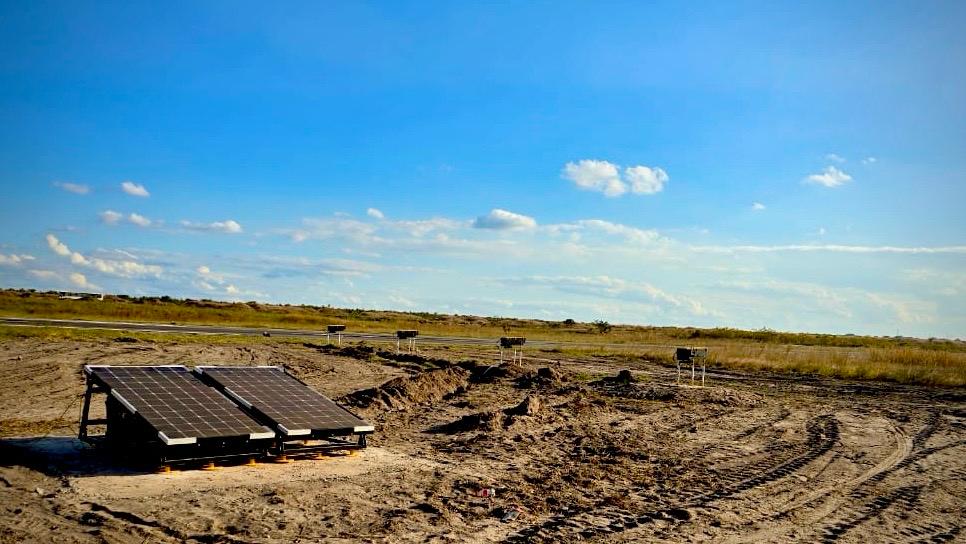




S4GA Solar Engine MAX powering PAPI lights at a remote airfield.
Every airport has different operational requirements depending on its size, weather conditions, climate, and airside usage. Yet all share one essential need: an airfield lighting system that performs reliably in any situation.
S4GA’s Solar Engines make this possible. Instead of relying on traditional power infrastructure, they capture and store solar energy, supplying a stable power source that keeps airfield lights operating entirely off-grid.
S4GA Solar Engines powering various airfield lighting systems during field operations.
Certain elements, such as the SP-401 solar airfield lighting unit, operate with an integrated solar panel and built-in batteries. Other components — including guidance signs, LED PAPI, wind direction indicators (WDI), and runway guard lights (RGL) — are powered by S4GA Solar Engines. The same setup is used for high-intensity runway and approach lights that form part of the Solar CAT I System, where Solar Engines serve as the main power source.
Each subsystem has unique technical parameters, such as light output, energy consumption, and frequency of use. These determine how much energy is required for smooth operation. Therefore, in an S4GA solar system, every component is paired with the most suitable type of Solar Engine to guarantee efficiency and reliable performance.
In this article, we explore how different types of airfield lighting equipment are powered in S4GA systems.
Precision Approach Path Indicators (PAPI) are the most energy-consuming AGL elements, requiring a robust and continuous power supply. They are typically supported by the largest of S4GA’s solar engines—the Solar Engine Max.
S4GA LED PAPI System powered by a Solar Engine MAX at Chartres Airport, France.
Equipped with two powerful solar modules (total capacity 720 W) and a large 5280 Wh power bank, the SE Max can reliably operate full PAPI or A-PAPI systems. It provides sustainable, stable illumination, providing pilots with dependable visual guidance at all times without a grid connection. Dave Forrest Airport in Australia, operated by Fortescue, adopted S4GA PAPIs as a part of the complete solar airfield lighting system to reduce environmental impact and improve operational safety.
S4GA LED-illuminated airport guidance signs are also powered by solar energy. Depending on the sign’s size and the airport’s operational requirements, different Solar Engine types are used.
S4GA Solar-Powered Guidance Sign at Tefé Airport, Brazil. Photo by Patrícia C Almeida.
These engines provide the right balance between capacity and autonomy. This ensures consistent operation while optimizing space and weight for practical installation. Tefé Airport, a key regional hub in Brazil operated by VINCI Brazil, has implemented S4GA LED-illuminated guidance signs as a part of the AGL system, efficiently powered by Solar Engines.
Airfield lighting components that require relatively low amounts of energy—such as runway guard lights and illuminated wind direction indicators—are powered by the Solar Engine Mini.
These engines are fully self-sustaining, harvesting energy during daylight and storing surplus power in onboard batteries for reliable operation during low-light or nighttime conditions.
S4GA Illuminated WDI powered by a Solar Engine MINI at Kolwezi International Airport, DRC.
Kolwezi International Airport in the Democratic Republic of Congo efficiently uses illuminated wind direction indicators powered by Solar Engines. S4GA’s system marked a historic milestone as the airport’s first permanent solar runway lighting installation.
The S4GA Solar CAT I system is built on the same principles as all S4GA solutions — delivering safe, dependable, and sustainable airfield lighting for modern airports. It encompasses both runway and approach lighting, integrated into a unified solar network, ensuring full operation without a grid connection.
Each light in the system is paired with a dedicated Solar Engine designed to provide the right balance of energy capacity and reliability. For example, each runway edge light is powered by its own Solar Engine Mini, while the approach bars are supplied by Solar Engine Compact.
The system meets ICAO Annex 14 CAT I photometric and operational requirements. It provides consistent light intensity, uniformity, and color, maintaining full autonomy for precision approach operations.
As a leader in the solar airfield lighting industry, S4GA does not believe in one-size-fits-all solutions. We design every system with optimally matched solar engines for each airport’s needs. Our team uses a data-driven approach—including feasibility studies, on-site testing, and performance validation. This guarantees that the AGL system is:
S4GA Solar Runway Lighting System operating at night at an international airport.
Regardless of airport location, size, or operational requirements, S4GA solar airfield lighting systems deliver reliable, energy-independent, and maintenance-friendly solutions.
Contact us for more information.